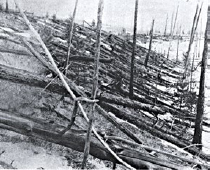1908
Tunguska Explosion
Leonid Kulik (1883–1942)
Many of the residents of what is now the Krasnoyarsk Krai region of remote central Siberia, near the Tunguska River, were startled awake on the morning of June 30, 1908, by a spectacular event. Around 7:15 a.m. the skies above Siberia erupted in what eyewitnesses reported as a blinding flash of light followed by thunderous explosions. The ground shook with the force of a magnitude 5.0 earthquake; a fierce hot wind and a rain of fire stripped and felled 80 million trees over more than 811 square miles (2,100 square kilometers)—an area half the size of Rhode Island. Seismic shock signals from the event were recorded across Asia and Europe, and night skies around the world glowed with an eerie light for several days afterward.
Scientists suspected that the residents of Tunguska had experienced a meteoroid impact. The first scientific group to study the remote, uninhabited region didn’t arrive until 1927, however, when the Russian mineralogist Leonid Kulik searched in vain for the resulting impact crater and potentially valuable iron-nickel meteorite deposits. Apparently, the event was primarily an airburst explosion, with surface damage caused by shock waves, heat, and fire—but with no associated crater formed.
Planetary scientists have debated the nature of the impactor for more than a century, with many claiming that it must have been an icy comet fragment that disintegrated catastrophically from atmospheric entry, and others claiming that the object must have been a small, rocky asteroid, perhaps a rubble-pile object that also was too weak to survive to the surface. Whatever its origin, an object only about 33 feet (10 meters) across traveling at around 6 miles (10 kilometers) per second exploded around 6 miles (10 kilometers) above the surface with an energy of about 10 megatons of TNT—or about 1,000 times the explosive yield of a World War II atomic bomb.

1927 photo from the Kulik expedition.
Amazingly, no one was known to have been killed by the Tunguska explosion. Tunguska was a wake-up call for understanding impact events, especially the catastrophic effects that even small objects traveling at extreme velocities can have on our environment when they occasionally slam into our planet.
SEE ALSO Cambrian Explosion (550 Million BCE), Dinosaur-Killing Impact (65 Million BCE), Arizona Impact (c. 50,000 BCE).
Artist and planetary scientist William K. Hartmann’s impression of the Tunguska forest one minute after the airburst explosion. The painting was made at Mount St. Helens, where the 1980 blast from that volcano produced a Tunguska-like scene.
